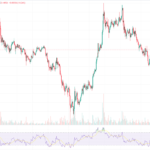In the fast-paced world of cryptocurrencies, every moment counts. The digital realm is abuzz with the latest updates, market shifts, and regulatory developments that can make or break fortunes in a heartbeat. As enthusiasts and investors alike strive to stay on top of the game, the quest for reliable information becomes a vital lifeline. Enter the realm of **crypto last news**, where insights are currency and knowledge is power.
Today, amidst the whirlwind of crypto happenings, a standout headline emerges: **”Bitcoin Surges to New All-Time High as Ethereum Faces Turbulence”**.
The behemoth of cryptocurrencies, Bitcoin, has once again shattered records, sending shockwaves through the market. Meanwhile, its counterpart Ethereum finds itself navigating choppy waters, grappling with challenges that could shape its future trajectory. These contrasting narratives underscore the volatile nature of the crypto sphere, where fortunes are made and lost in the blink of an eye. Stay tuned as we delve into the heart of these developments, decrypting the signals that drive the pulse of the digital economy.
Bitcoin Hits New All-Time High
The world of cryptocurrencies is no stranger to volatility, and Bitcoin’s recent surge to a new all-time high is a testament to this fact. As the pioneer of digital currencies, Bitcoin has always been at the forefront of market movements, capturing the attention of investors and enthusiasts alike. With its recent rally, Bitcoin has once again proven its resilience and potential for exponential growth.
Investors have been closely monitoring Bitcoin’s price movements, eagerly awaiting the moment when it would break through previous records. And that moment has finally arrived. Bitcoin’s meteoric rise has not only solidified its position as the leading cryptocurrency but has also sparked renewed interest in the digital asset space.
While some skeptics may argue that Bitcoin’s surge is nothing more than a speculative bubble waiting to burst, many experts believe that this rally is different. They point to various factors such as increased institutional adoption, growing mainstream acceptance, and limited supply as catalysts for Bitcoin’s upward trajectory.
As the crypto last news unfolds, it becomes increasingly clear that Bitcoin’s journey is far from over. The digital currency continues to captivate both seasoned investors and newcomers alike, offering a glimpse into the future of finance.
Ethereum’s Turbulent Journey
While Bitcoin steals the spotlight with its record-breaking performance, Ethereum finds itself facing a different set of challenges. As one of the most prominent altcoins in the market, Ethereum plays a crucial role in shaping the decentralized finance (DeFi) landscape.
However, recent events have cast a shadow over Ethereum’s path forward. The network congestion caused by increased demand for DeFi applications has led to skyrocketing transaction fees and slower processing times. This scalability issue has raised concerns among users and developers alike.
Despite these hurdles, Ethereum remains a force to be reckoned with. Its smart contract capabilities and vibrant ecosystem have attracted countless projects and developers, solidifying its position as the go-to platform for decentralized applications.
As Ethereum navigates these turbulent waters, the crypto community eagerly awaits solutions that can address its scalability challenges. Whether it’s through the implementation of Ethereum 2.0 or other scaling solutions, the future of this altcoin holds immense potential.
Market Analysis: Bitcoin vs. Ethereum
When it comes to comparing cryptocurrencies, Bitcoin and Ethereum often take center stage. These two digital assets represent different facets of the crypto market and have distinct roles within the ecosystem.
Bitcoin, with its limited supply and store-of-value narrative, has positioned itself as a digital alternative to traditional currencies. Its decentralized nature and scarcity make it an attractive investment option for those seeking a hedge against inflation or a safe haven asset.
Ethereum, on the other hand, is more than just a cryptocurrency. It serves as a platform for building decentralized applications (dApps) and executing smart contracts. The Ethereum network has become synonymous with innovation in areas such as DeFi, non-fungible tokens (NFTs), and decentralized exchanges (DEXs).
While both Bitcoin and Ethereum have experienced significant growth in recent years, their trajectories are driven by different factors. Bitcoin’s price movements often correlate with macroeconomic events and investor sentiment towards cryptocurrencies as a whole. On the other hand, Ethereum’s success hinges on its ability to overcome scalability challenges and maintain its position as the leading platform for dApps.
Understanding these dynamics is crucial for investors looking to navigate the crypto market effectively. By analyzing market trends and evaluating each cryptocurrency’s unique value proposition, individuals can make informed decisions that align with their investment goals.
Impact on Altcoins and DeFi Projects
Bitcoin and Ethereum’s performance has a ripple effect throughout the entire cryptocurrency market. As the dominant players, their movements often dictate the overall sentiment and direction of altcoins and DeFi projects.
When Bitcoin experiences a surge, it tends to drive up the prices of other cryptocurrencies as well. This phenomenon, known as the “altseason,” is characterized by increased investor interest in alternative digital assets. During these periods, altcoins with promising technology or unique value propositions often see substantial gains.
Similarly, Ethereum’s success has a direct impact on the DeFi sector. As the primary platform for decentralized applications, any challenges faced by Ethereum can have far-reaching consequences for DeFi projects built on its network. High transaction fees and slow processing times can hinder user adoption and limit the growth potential of these projects.
It is essential for investors to keep a close eye on how Bitcoin and Ethereum’s performance affects altcoins and DeFi projects. By understanding these interdependencies, individuals can identify investment opportunities that align with emerging trends in the crypto market.
Regulatory Updates: Navigating the Legal Landscape
The cryptocurrency industry operates within a complex regulatory landscape that varies from country to country. Governments around the world are grappling with how to approach cryptocurrencies, leading to an evolving set of rules and regulations.
Staying informed about regulatory updates is crucial for individuals involved in crypto last news. Changes in legislation can have significant implications for investors, exchanges, and businesses operating within the crypto space.
In recent years, regulatory bodies have focused on issues such as anti-money laundering (AML) measures, know-your-customer (KYC) requirements, taxation guidelines, and investor protection. Compliance with these regulations is essential to ensure the legitimacy and long-term viability of cryptocurrencies.
As the crypto market continues to mature, regulatory clarity becomes increasingly important. Clear guidelines can foster innovation, attract institutional investors, and provide individuals with a sense of security when participating in the digital economy.
Institutional Adoption: A Game-Changer for Cryptos
The entry of institutional players into the cryptocurrency space has been a game-changer. Traditional financial institutions, hedge funds, and corporations are recognizing the potential of cryptocurrencies as an investment asset class.
Institutional adoption brings increased liquidity and stability to the market. Large-scale investments from institutional players can help legitimize cryptocurrencies and pave the way for further mainstream acceptance.
Moreover, institutional involvement often leads to more sophisticated trading strategies and investment products. The introduction of Bitcoin futures contracts and exchange-traded funds (ETFs) provides investors with additional avenues to gain exposure to cryptocurrencies.
As more institutions enter the crypto market, it is crucial to monitor their activities and assess their impact on prices and market dynamics. Institutional adoption has the potential to shape the future of cryptocurrencies in profound ways.
Price Predictions and Expert Forecasts
One of the most exciting aspects of following crypto last news is uncovering expert predictions and forecasts about cryptocurrency prices. Analysts employ various methodologies, including technical analysis, fundamental analysis, and sentiment analysis, to gauge where prices may be heading.
It’s important to note that price predictions should be taken with a grain of salt. The cryptocurrency market is highly volatile and subject to numerous external factors that can influence prices in unexpected ways.
However, expert forecasts can provide valuable insights into market trends and potential catalysts for price movements. By considering multiple perspectives and conducting thorough research, individuals can make more informed decisions when buying or selling cryptocurrencies.
Cryptocurrency Security: Safeguarding Your Assets
As the value of cryptocurrencies continues to rise, ensuring the security of digital assets becomes paramount. Cryptocurrency thefts and hacks have made headlines in recent years, highlighting the importance of robust security measures.
Individuals must take proactive steps to safeguard their crypto holdings. This includes utilizing secure wallets, implementing two-factor authentication (2FA), and practicing good cybersecurity hygiene.
Additionally, individuals should be cautious when interacting with unknown or unverified projects. Scams and fraudulent schemes are prevalent in the crypto space, and it’s essential to conduct thorough due diligence before investing or participating in any project.
By prioritizing security and staying informed about best practices, individuals can minimize the risk of falling victim to cybercrime and protect their hard-earned assets.
Decentralized Finance (DeFi) Innovations
The rise of decentralized finance (DeFi) has been one of the most significant developments in the cryptocurrency space. DeFi encompasses a wide range of financial applications built on blockchain technology that aim to disrupt traditional financial intermediaries.
From lending and borrowing platforms to decentralized exchanges and yield farming protocols, DeFi offers individuals unprecedented control over their finances. By eliminating intermediaries, DeFi projects strive to provide greater transparency, accessibility, and efficiency.
However, it’s important to note that DeFi is still an emerging sector with its own set of risks. Smart contract vulnerabilities, market manipulation, and regulatory uncertainties pose challenges that need to be addressed for widespread adoption.
As DeFi continues to evolve, it presents exciting opportunities for investors looking to participate in this innovative space. Understanding the underlying technology and conducting thorough research are crucial when navigating the world of DeFi.
Conclusion: Navigating the Crypto Waters
The world of cryptocurrencies is a dynamic and ever-evolving landscape. From Bitcoin’s record-breaking highs to Ethereum’s scalability challenges, the crypto market is filled with opportunities and risks.
Staying updated on the latest crypto last news is essential for investors and enthusiasts alike. By understanding market trends, regulatory developments, and technological advancements, individuals can navigate the crypto waters with confidence.
Remember to conduct thorough research, seek advice from trusted sources, and exercise caution when making investment decisions. The cryptocurrency market may be volatile, but with knowledge and informed decision-making, individuals can unlock the potential of this exciting digital frontier.
Bitcoin price corrects 3% as GBTC investors dump nearly $600 million
In recent news, Bitcoin’s price experienced a minor correction as GBTC investors dumped nearly $600 million worth of shares. This sell-off by Grayscale Bitcoin Trust (GBTC) investors has raised concerns among some market participants.
The GBTC is a popular investment vehicle that allows institutional investors to gain exposure to Bitcoin without directly owning the cryptocurrency. The recent sell-off suggests that some institutional players may be taking profits or reallocating their investments.
While this correction may cause short-term volatility in Bitcoin’s price, it is important to remember that market movements are part of the natural ebb and flow of the crypto space. Investors should focus on long-term trends and fundamentals rather than being swayed by short-term fluctuations.
As always, staying informed about the latest developments in the crypto market will help individuals make sound investment decisions based on their risk tolerance and investment goals.











